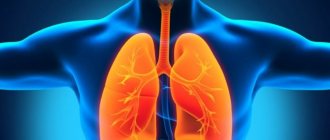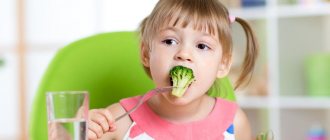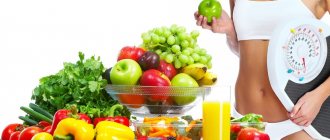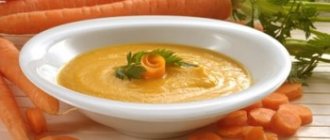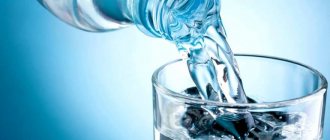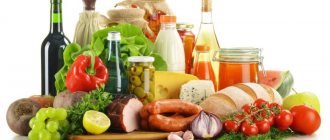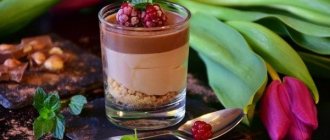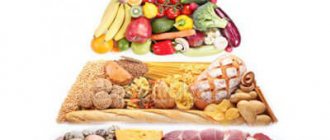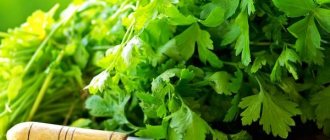Poor nutrition, stress and a frantic pace of life can lead to various “kickbacks” from the body that cannot keep up with you. First of all, this concerns the digestive system in general and the stomach in particular - it suffers the most from your hamburgers and pizzas eaten on the go. This often leads to gastritis, which, if neglected, becomes chronic.
The only thing that can help you in this case is thorough treatment, including dietary nutrition. Today we will analyze such nutrition, find out what kind of diet it is called “Table No. 2” and create a sample menu for every day.
What kind of diet is this, basic principles
This type of nutrition has several goals:
- completely replenish the physiological need for nutrients;
- reduce stimulation of secretion of the digestive tract organs to a physiological minimum;
- observe thermal and mechanical sparing of the gastric mucosa;
- normalize the motor function of the gastrointestinal tract.
Such a diet is necessary in order to create a kind of “vacation” for the stomach, to allow its damaged mucous membrane to recover, without compromising a person’s needs for basic nutrients.
The basic principles of this diet are the following recommendations:
- all dishes must be cooked using different methods of heat treatment (steamed, baked, boiled, stewed);
- you will have to give up fried delicacies;
- hot sauces and seasonings cannot be used in cooking;
- meals should be provided in fractions (up to 5 times a day, but in small volumes);
- the amount of salt in food should also be reduced;
- It is advisable to grind food or chew it thoroughly;
- You don’t have to change your drinking regime, but it is important to remember that at least 1.5 liters of fluid per day should enter your body;
- The temperature of the food should be pleasant; too hot or cold food is unacceptable (the same applies to drinking).
Lazy dumplings with dried apricots, dietary recipe with photos
A quick and tasty dish for which you will need:
- 250 g of cottage cheese,
- 1/3 cup flour,
- 1/3 cup semolina,
- one egg,
- 3 tablespoons sugar,
- 100 gr. dried apricots,
- butter.
Preparation:
- To prepare the dough, grind cottage cheese with sugar and egg, add semolina and flour. The curd dough is rolled into a ball, covered with cling film and left for 20 minutes. During this time, the dried apricots are ground using a meat grinder or blender.
- Make a thin roll from the dough and filling. To do this, the curd dough is rolled out into a long rectangle, along which the filling is laid out in a thin strip in the middle, and the upper and lower edges of the dough are tightly connected. Next, the roll is cut into small pieces 1-1.5 cm wide and cooked for 4 minutes.
- Lazy dumplings with dried apricots are served hot, with melted butter poured on top.
Indications for use
The reasons why a doctor may prescribe you a diet according to the “Table No. 2” diet may include pathologies such as:
- gastritis (in acute form during the recovery period);
- enteritis and colitis of various etiologies (for the transition to good nutrition at the end of the rehabilitation period);
- chronic form of gastritis with insufficient secretion;
- chronic gastritis during exacerbation and during subsequent rehabilitation;
- chronic forms of enteritis and colitis (if they are not associated with diseases of the liver, bile ducts, pancreatitis or gastritis with increased gastric secretion).
In some cases, such nutrition may be equivalent to a diet for a stomach ulcer, or a diet in the postoperative period (if the stomach has undergone surgery).
Berry soufflé dietary recipe for table 5
For berry souffle you will need to stock up on specific products:
- blueberries, black currants (a glass);
- egg whites (five pieces);
- sugar (two large spoons).
Cooking method:
- The berries are crushed in a blender along with sugar.
- Boil the mixture until thickened for about thirty minutes.
- Beat the whites.
- Mix jam and fluffy mass.
- Grease the mold with oil and pour in the mixture.
- Bake in the oven for 15 minutes at a temperature of two hundred degrees.
- The dessert is served sprinkled with powdered sugar.
What you can eat and what you can’t eat
We will give an approximate list of foods that you can eat if you are prescribed the “Table No. 2” diet:
- soups based on a decoction of vegetables, mushroom and low-fat meat and fish broth with finely chopped vegetables;
- any cereals except millet and pearl barley;
- steamed or baked puddings;
- durum wheat vermicelli;
- boiled, stewed or baked vegetables;
- finely chopped fresh herbs;
- lean varieties of meat and fish without films, skin and tendons;
- boiled or steamed offal (liver and tongue);
- dishes made from low-fat minced meat;
- eggs in any form (except fried);
- fresh ripe fruits and berries (except citruses);
- dairy products;
- stale wheat bread, poor pastries;
- plain cookies, dry biscuits;
- butter and vegetable oil;
- compotes and jelly;
- weak tea and coffee, cocoa with milk;
- berry decoctions;
- berry juices diluted in half with water.
Prohibited foods for this diet are the following:
- legumes in any form;
- milk soups (including okroshka);
- millet, pearl barley, barley and corn cereals;
- fatty fish and meat;
- raw hard fruits;
- figs, dates;
- chocolate and cream products, ice cream;
- fresh baked goods, puff pastry, baked goods;
- lard and other animal fats;
- grape juice and kvass;
- soda (including sparkling mineral water);
- smoked meats and preservation (in any form);
- spicy seasonings and sauces.
The following table shows a list of dishes that are recommended for the patient if the “Table No. 2” diet is prescribed:
The essence and purpose of the diet
Treatment table No. 2, as a rule, is used in the period after an exacerbation of the inflammatory process of the stomach and intestines; before that, diet No. 1 is used. It is important to know that such a diet may not be suitable for patients with concomitant diseases of the pancreas, liver and gallbladder.
Therefore, such a diet should be prescribed exclusively by a gastroenterologist based on the general condition of the patient and the results of laboratory and instrumental tests. : If the patient's condition worsens and the symptoms of the disease progress, the doctor prescribes a different course of treatment and diet.
The goal of this program is to stimulate the normal secretion of digestive enzymes. With the virtual absence or insufficient production of digestive juices, the normal process of digestion is impossible.
That is why the goal of diet therapy using table No. 2 is to restore digestive function. In addition, during therapeutic nutrition, the motility of the digestive tract improves. Gastrointestinal motility ensures the movement of food through the digestive tract and its mixing with gastric juice. Violations of this function are also dangerous and extremely undesirable.
Table number 2 is characterized as a complete and balanced diet. The list of prohibited foods includes hard-to-digest, fatty and spicy foods. Almost all types of heat treatment are allowed. The patient must eat at least 2800 kcal per day, this is the daily caloric intake for an ordinary person. That is, you don’t have to starve or severely restrict yourself, and it’s not even allowed. Particular attention is paid here to mechanical sparing.
The chemical composition of the diet should consist of all the vitamins and microelements the body needs. Every day you need to consume approximately 100 g of proteins and fats, both vegetable and animal, and supplement with 400 g of carbohydrates.
To accurately navigate the amount of components consumed, it is better to find recipes indicating the content of proteins, fats, carbohydrates, as well as calorie content per 100 g of dish or food product. Such recipes are most common on websites for athletes and health portals. In general, you need to eat a little of everything a day: dietary meats, poultry, white fish, cereals, vegetables, fruits. It is recommended to eat plant foods not raw, but cooked. You also need to limit the amount of salt - no more than 15 grams per day.
Mechanical processing of dishes for table No. 2: food should be finely chopped, pureed, soft, mushy. Lean fish fillets do not need to be chopped; the main thing is to eat them without skin. Everything else should be in the form of baby food, soups - not rich and liquid (not bone and with a second broth), porridge - pureed, fillets for cutlets and meatballs - it is better to pass through a meat grinder several times.
Heat treatment: the diet should consist of approximately 80% boiled or steamed foods. Food can also be baked, stewed or fried. The main thing is that there is no thick crust. When frying, it is not allowed to use breading in breadcrumbs or batter with flour. The food consumed should only be warm: not very cold and not too hot. It is also not allowed to overeat; there should be 4-5 moderate servings per day.
So, to recover from gastritis and related diseases, you need to eat warm, soft food, divided into 4-5 meals. You can't overeat and starve. The basis of the diet should be cooked ingredients.
Sample menu for a week for the “Table 2” diet
To make it easier for you to create your diet if you have been prescribed the second Pevzner diet, we will provide an indicative menu for the week. This is just an example, you can make your own list of dishes for the week. The main thing is to follow the basic principles of this diet and coordinate your desires with the list of permitted foods. In addition, it is important to drink a glass of kefir before going to bed, on any day of the therapeutic diet.
Monday
- Breakfast is allowed with semolina pudding, boiled egg and tea.
- For lunch, treat yourself to fruit jelly.
- For lunch, noodle soup in chicken broth with pieces of boiled chicken, steamed meat soufflé and berry compote will not be out of place.
- You can have an afternoon tea with simple cookies.
- For dinner, buckwheat pudding with cottage cheese and fruit jelly are suitable.
Tuesday
- You can start your morning with sweet rice porridge, crackers and weak coffee.
- You are allowed to have a snack with cottage cheese and rosehip decoction.
- For lunch, eat borscht, potato casserole with meat and dried fruit compote.
- A baked apple is perfect for an afternoon snack.
- For your last meal, prepare steamed turkey cutlets, pureed buckwheat porridge and green tea.
Wednesday
- You can start the day with cottage cheese soufflé, boiled eggs and weak coffee with milk.
- Lunch can be celebrated with berry jelly.
- For lunch you are allowed to eat meat broth soup with rice, potato casserole with minced chicken and berry jelly.
- As an afternoon snack, biscuits and a decoction of rose hips are suitable.
- For dinner, prepare vegetable soufflé, steamed fish cutlets and herbal tea.
Thursday
- For breakfast, a steamed omelette, sweet pasta with cottage cheese and weak coffee with milk are suitable.
- For lunch you can eat some hard cheese and drink berry jelly.
- For lunch, prepare light noodle soup with turkey broth, steamed meat cutlets, mashed potatoes and apple compote.
- You are allowed to snack on berry jelly.
- For the last meal, boiled cauliflower, buckwheat pudding and rose hip broth are suitable.
Friday
- It's best to start the day with oatmeal with milk and a boiled egg.
- For a snack, apple soufflé is perfect.
- For lunch you can eat vegetable soup with meatballs, boiled or steamed rabbit meat, noodles and tea.
- It is enough to celebrate the afternoon snack with crackers and fruit jelly.
- For dinner, steamed fish cutlets with mashed potatoes and the same rosehip broth are allowed.
Saturday
- You can have breakfast with milk buckwheat porridge, cottage cheese casserole and coffee.
- Snacks are allowed with a small amount of marshmallows and jelly.
- For lunch, prepare pureed cauliflower soup, a casserole of pre-boiled veal and potatoes, and weak black tea.
- For an afternoon snack, diluted juice and cookies will do.
- For your evening meal, eat baked fish, boiled rice and compote.
Sunday
- For breakfast, oatmeal with milk, steamed omelet and cocoa are suitable.
- For lunch you can prepare pureed cottage cheese and rosehip infusion.
- For lunch, treat yourself to soup with meatballs, vegetable stew with meat and tea.
- For a snack, you can eat berry mousse.
- For your last meal, treat yourself to steamed fish cutlets, mashed rice, cottage cheese casserole and oatmeal jelly.
Diet 5 zucchini dishes. 5 amazing diet dishes with zucchini
All the best for your health!
1. Zucchini breaded with soft cheese
Ingredients:
- Zucchini - 500 g
- Egg - 2 pcs
- Hard cheese 100 g
- Dry herb mixture as desired
- Salt, pepper - to taste
Preparation:
Peel the zucchini and cut into sticks. Beat the egg with salt and pepper, grate the cheese on a fine grater, add herbs and mix. Dip each stick in egg, bread in cheese, and place on a baking sheet lined with baking paper. Bake the zucchini in a preheated oven at 180 degrees until golden brown. Eat warm.
2. Chicken cutlets with carrots and zucchini
Ingredients:
- Minced chicken fillet - 200 g
- 1 large carrot
- 1 small zucchini (500 grams)
- 1 onion
- 1 protein
- Spices to taste
Preparation:
Grate carrots, zucchini and onions on a coarse grater, mix with minced meat, egg and spices. Form cutlets with wet hands and bake in the oven at 180° until golden brown (20-40 minutes depending on size).
3. Zucchini Lasagna: A super healthy dinner!
Ingredients:
- Chicken fillet – 300 g
- Zucchini – 400 g
- Carrots – 1 pc.
- Egg – 1 pc.
- Onion – 1 pc.
- Natural yogurt – 4 tbsp. l
- Low-fat cheese – 100 g
- Tomato paste – 1 tbsp. l
- Salt, pepper - to taste
Preparation:
Grind chicken fillet into minced meat. In a frying pan, fry minced chicken, chopped onion, grated carrots with a little oil, add a little water and simmer for 10 minutes over low heat. Add tomato paste and fry for 3 minutes, stirring constantly. Add salt and pepper to taste. Cut the zucchini into thin layers.
Place half the squash layers in a fireproof dish with a flat bottom. Place half of the fried minced meat on the zucchini. In a bowl, whisk the egg with yogurt and salt. Pour half of the egg-yogurt mixture onto the minced meat. Then repeat all layers. Sprinkle with grated cheese and place in an oven preheated to 200 degrees until done. Once the zucchini has become soft and the cheese has browned, you can remove it from the oven. Lasagna is ready, serve hot.
4. Zucchini stuffed with chicken
Ingredients:
- Zucchini - 4 pcs
- Chicken fillet – 600 g
- Onion - 1/2 pcs
- Lemon zest - 1 pc.
- Garlic – 7 g
- Mixture of Provencal herbs - 1 tsp
- Salt, pepper - to taste
Preparation:
Grind the chicken fillet into minced meat. Using a teaspoon, scrape out the pulp from the zucchini - a boat with walls about 1 cm thick or a little less should remain. Place the boats on a baking sheet and add salt. Finely chop the removed pulp and add to the minced meat along with lemon zest, grated garlic, finely chopped onion, herbs, salt and pepper. Knead. Place in zucchini. Place in oven preheated to 200 degrees and bake until tender, about 30-35 minutes.
5. Zucchini baskets
Ingredients:
- Zucchini - 500 g
- Chicken fillet – 200 g
- Salt, spices - to taste
- Egg - 1 pc.
- Low-fat cheese – 50 g
- Olive oil
Preparation:
Peel the zucchini and grate on a coarse grater. Squeeze out the liquid, add the egg, salt and mix well. Cut the chicken fillet into small cubes, add salt, sprinkle with spices and fry for 5 minutes. Distribute the zucchini mass over the bottom and walls of the silicone molds. Place the chicken fillet in the center. Sprinkle with grated cheese. Place in the oven preheated to 200*C for 30 minutes.
Enjoy!
Medical diet “Table No. 2” – video
This video describes in detail the “Table No. 2” diet, its basic principles and cases when it can be prescribed to a patient. A list of allowed foods is also given, as well as those that you will have to forget about during treatment.
The diet “Table No. 2” is designed to solve your problems with chronic gastritis, as well as gastritis, in which gastric secretion is reduced, in contrast to the similar diet table No. 1, which is focused on increased secretion. This diet is much softer and more varied than the same intestinal diet, table No. 4, but, nevertheless, the list of products allowed for consumption is poorer than in table No. 10.
Despite the difference with other diets according to Pevzner, nutrition on the second table gives its results. Such consumption of quite familiar foods, which is gentle on the stomach, allows the mucous membrane to recover and work normally.
Have you ever eaten according to the “Table No. 2” diet? For what pathology were you prescribed this diet? Did you get results after such restrictions on the menu? Share your experience and delicious recipes for healthy dishes as part of this diet, this will definitely help patients who have been prescribed such food restrictions for the first time. Good health to you and a speedy solution to your “problems”!
Recipes for every day
From acceptable ingredients, it is quite possible to prepare delicious and harmless dishes for every day.
Carrot rice soup
Cream soup for table number five is prepared from the following ingredients:
- carrots (two pieces);
- onion (one piece);
- low fat cream (50 milliliters);
- cream-based butter (large spoon);
- rice cereal (200 grams).
Cooking method:
- Boil the rice grains until tender.
- Chop the onion and lightly sauté in butter.
- Grate the carrots and add them to the pan.
- Remove from heat after ten minutes.
- Put a liter of water on the fire.
- Throw food into the liquid after it boils.
- Cook the mixture for 3-5 minutes.
- Grind everything with a blender and add cream.
- Boil again.
Before serving, sprinkle the soup with parsley.
Steamed omelette
Instead of traditional fried eggs, the fifth table offers a steam omelet. It is prepared from the following products:
- three egg whites;
- a pinch of salt;
- greens to taste;
- a glass of milk.
Preparation progress:
- The protein is thoroughly mixed with milk and salted.
- Take a saucepan and a colander.
- Water is poured into the dishes, which should not touch the colander.
- Bring the liquid to a boil and install a mesh ladle, and place a bowl with the egg mixture and herbs in it.
- Cover the pan with a lid and cook for twenty minutes.
For patients who are lactose intolerant, a similar recipe with water is suitable.
Diet pilaf
To prepare pilaf without harmful additives you will need certain ingredients:
- beef without veins (450 grams);
- rice (500 grams);
- carrots (three pieces);
- onion (one piece);
- a little salt.
Cooking method:
- The meat is boiled until it becomes tender.
- The beef is cut into medium pieces.
- The carrots are peeled and grated.
- Chop the onion into cubes.
- Place the vegetables in a thick-walled pan and add the meat.
- Stew food over low heat.
- Throw in washed rice and fill with water. It should be one centimeter higher than the cereal.
- Simmer the contents of the pan until the rice absorbs all the liquid. If necessary, add water and stir.
- Sprinkle salt.
Chicken is allowed instead of beef.
Allowed and prohibited food ingredients
The following food components may be included in the diet, subject to table No. 2:
- Any varieties of cereals, with the exception of millet, pearl barley and corn.
- Cookies without added sugar, crackers made from wheat bread, day-old bakery products made from wheat flour with added bran, biscuits.
- Any type of fish containing a minimal amount of fat. It is permissible to cook fish in any way, avoiding breading.
- Any types of fermented milk and dairy products. Dairy cream with a high percentage of fat content, as well as whole milk with a fat content of more than 2.5%, are subject to partial restrictions.
- Weak broths made from red meat, poultry without skin, vegetables or fish.
- Among confectionery products, it is allowed to consume beet and cane sugar, fruit and berry jams, marshmallows, marmalade, marshmallows, sweets, and natural honey.
- Hibiscus tea, rosehip uzvar, herbal decoctions and infusions, weak green and black tea, a warm drink made from fried chicory roots.
- It is permissible to eat any vegetable components, with the exception of radishes, garlic, beans and peas, onions, horseradish and radishes. Dishes made from vegetables are recommended to be served pureed.
- The meat components used are veal, skinless chicken and turkey, as well as rabbit meat.
To prepare fruit and berry jelly, you can use potato or corn starch.
To avoid negative reactions from the digestive system, the following products should be completely excluded from the daily diet:
- Grape juice, figs, dates.
- Bread and malt kvass.
- Vegetables cooked in salted, pickled and pickled form.
- Any types of canned fish and vegetables.
- Smoked meat and fish ingredients.
- Pastries, cakes, puff pastry and pastry products.
- Duck and goose meat, pork, lamb and bacon.
- Drinks containing carbon dioxide or ethyl alcohol.
- Chocolate, cocoa.
- All varieties of mushrooms.
- Pork and beef fat, margarine, cooking oil.
- Ice cream, energy drinks.
